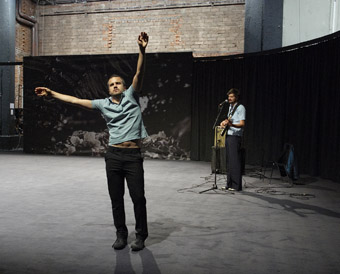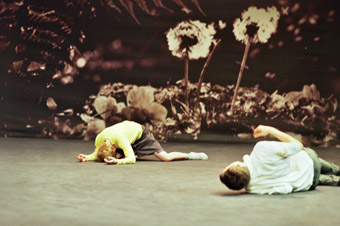when does forever end?
joelle Jacinto: meg stuart & philipp gehmacher’s maybe forever

Maybe Forever, Philipp Gehmacher, Niko Hafkenscheid
photo Eva Wordinger
Maybe Forever, Philipp Gehmacher, Niko Hafkenscheid
A COUPLE, TRYING TO SLEEP THROUGH THE EARLY MORNING, LANGUIDLY SEEK THAT PERFECT POSITION BUT FIND THEMSELVES SUBCONSCIOUSLY REACHING FOR AND GRABBING ONE ANOTHER, AND NOT-SO-SUBCONSCIOUSLY PUSHING EACH OTHER AWAY, OR JUST PRETENDING NOT TO RESPOND. PRETENDING TO SLEEP. PRETENDING THAT EVERYTHING IS ALRIGHT.
In Meg Stuart and Philipp Gehmacher’s Maybe Forever, the pair then sit with legs outstretched and backs to the audience, leaning to the side at the same angle, plagued by a weight that neither can ignore. The performance space is hazily semi-lit, reminding me of the way light creeps into your bedroom at dawn. There is little stylization in the way the couple suddenly grab each other and spread against each other full length only to discreetly remove themselves from contact to find another spot on the floor; but this push-and-pull feels like a dance.
The basic movement in Maybe Forever is built around a soft hunching of the shoulders, drawing the arms up and outward, or crossing over in front of the body, in a subtly awkward manner. Both Stuart and Gehmacher do this, sometimes together, sometimes by themselves, but regularly throughout the 80 minutes of the work. Audiences familiar with Gehmacher’s work will recognize this as his preferred style. I don’t know his purpose for such movement, but it feels very apt for Maybe Forever.
The movement I’ve described is first seen in the fourth segment of the work, when Gehmacher re-enters the stage, if hinted at by Stuart in the third segment. Right after the early morning ‘pas de deux,’ guitarist Niko Hafkenscheid croons a song to us with “maybe forever…” in the lyrics. Stuart enters, wearing a skirt and blouse under a thick leather jacket, faces the audience and speaks as if to a former lover: “Remember when I said I wish you were here? I take it back.”
She mentions many things she would rather take back from her relationship, and quite a few things that she decided she doesn’t want to take back after all. As she speaks, she makes one or two brisk movements with her arms to punctuate or even halt her sentences, echoing the work’s movement motif, if not always obviously. Each time she moves her arms, her jacket squeaks, suggesting that in these confessions Stuart is largely uncomfortable, just trying to give herself more room to breathe.

Maybe Forever, Meg Stuart, Philipp Gehmacher
photo Chris van der Burght
Maybe Forever, Meg Stuart, Philipp Gehmacher
As soon as she is done, Gehmacher enters, carrying another microphone stand, but instead of speaking, he abandons it for centrestage where he performs a solo, hunching his shoulders to direct the movement of his arms which rise and fall and cross, both limp and stiff, in front of his torso.
He joins Stuart, who is stretched out on an elevated platform on the left side of the stage and tries to lie with her. He gets up quickly, turns away and then returns. She moves away, turns back to give him a full embrace, falls away again. And so they continue their earlier duet more lucidly, with the push-and-pull more pronounced—and we finally see that this signifies an inability to embrace.
Later there are more serious attempts to embrace, more effort to make things work, but also more despair, and a stronger sense of sadness. Stuart walks offstage, away from Gehrmacher more than once. He ignores this the first time, follows her on the second instance, he does not go far enough, choosing to wallow in self pity, perhaps, by a concrete wall, shoulders hunched, rather than running to reclaim her.
Stuart returns, as if to give Gehmacher another chance, performing a solo as he stands alone in a far corner. By now, I feel quite agitated by this continuing dance of frustration, as if experiencing it myself. I find this quite brilliant; it’s not spectacular but it is definitive. I have to admit that all this time I am waiting for a happy ending, that I want the “forever” to be the inevitable, instead of merely possibile. But even after the pair find each other in a successfully complete and tight embrace, he then fails to register where she goes next, never mind that she is constantly looking back to him, beckoning.
In few words and little movement, a relationship and everything wrong with it has been transformed from private memory to shared experience. It is as if the audience has been on this journey with the dancer-choreographers, felt the same hope and frustration, the same love and loss of love. At the end, Gehmacher finally takes the microphone to haltingly tell us that he is “ready…now…to…” Obviously he is not ready after all, as he looks at Stuart—sitting calmly to the side and now in a bright orange dress—probably waiting for her to finish the sentence for him. But she doesn’t. She just looks back at him, with none of the previous sadness or frustration, not giving him another chance this time. I was not surprised at the eruption of applause as the lights went out.






